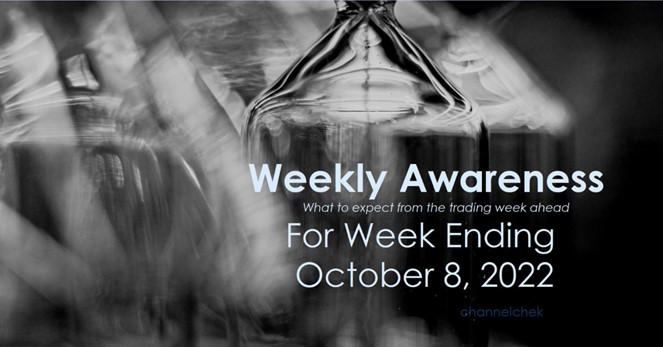
Monitoring the Week Ahead – Week Ending October 8th
Today is the first trading week of the new quarter and the first in October. It’s the start of what many hope will be a market turnaround and a strong positive close to the year.
Taking the new month and new quarter one day at a time, below are events scheduled this week that could prove important to our Channelchek subscribers. US data and events will be heavy most days this week, opening with the ISM Manufacturing Survey Monday and ending with monthly Employment on Friday. A variety of Fed Governors will be talking on a number of critical subjects, those talks most likely to move markets are listed.
All times are Eastern Time.
Monday 10/3
- Noble Capital Markets in Chicago, interview E.W. Scripps (attend live)
- 9 am Raphael Bostick, Federal Reserve Bank of Atlanta, President/CEO, Discusses technology and Disruption. Follow
- US Construction Spending 10 am – This reports the dollar value of new construction activity on residential, non-residential, and public projects. Construction spending fell 0.4 percent in July, marking the sixth straight lower-than-expected result. August’s consensus is a 0.1 percent decline.
- ISM Manufacturing Index 10 am – The survey gathers information from managers about the general direction (tracked in volumes) of production, new orders, order backlogs, inventories, employment, supplier deliveries, exports, and imports. It was 52.8 in each of the last two reports, this shows the ISM manufacturing index has stabilized at a level of modest growth. September’s consensus is 52.4.
- TD Ameritrade’s Investor Movement Index 12:30 – The Investor Movement Index, (IMX), is a behavior-based index created by TD Ameritrade designed to shed insight into Main Street sentiment. The IMX strives to measure what investors are actually doing and how they are positioned in the markets. The index is a snapshot, but when compared to previous periods may be helpful to uncover trends or changes in focus.
Tuesday 10/4
- Noble Capital Markets in Chicago, interview E.W. Scripps in Milwaukee (attend live)
- Factory orders are a leading indicator. It is the dollar amount of new orders for both durable and nondurable goods. Factory orders are seen gaining 0.2 percent in August, which would follow a 1.0 percent decline in July. Durable goods orders, which have already been released and are one of two major components of this report, fell 0.2 percent in the month.
- The Labor Department’s JOLTS has in recent years been referred to as the “Quits” report. The report tracks monthly changes in job openings and contains rates on hiring and quitting. The word JOLTS stands for Job Openings and Labor Turnover Survey.
Wednesday 10/4
- OPEC meeting. OPEC meetings and the announcements post meeting with changes to production quotas, raising or lowering the global supply of crude oil can have a dramatic impact on energy prices, which currently have been feeding into inflation and business costs. The Organization of Petroleum Exporting Countries and associate members meet monthly.
- U.S. MBA Mortgage Applications at 7 am. This is a gauge of both the demand for housing and economic momentum. Families and individuals are usually feeling comfortable and confident in their own financial position to buy a house. The changes in housing provide data that has a significant multiplier effect acting on the economy as other purchases follow. The indicated change in economic activity impacts many industries and investment markets.
- U.S. International Trade in Goods and Services at 8:30. Trade numbers are available by export, import, and trade balance for six principal end-use commodity categories. The numbers will be for August and are expected to show a deficit of $68.0 billion for total goods and services trade which would compare with a $70.6 billion deficit in July. Advance data on the goods side of August’s report showed a nearly $3 billion narrowing in the deficit.
- The U.S. PMI Composite (Final) or Purchasing Managers Index released at 9:45 am is based on a monthly survey collected from over 400 U.S. companies. The companies provide a leading indicator of what is occurring in the private sector economy. At 49.2, the first indicator for September showed improvement from August’s 43.7. No change at 49.2 is the expectation for the final.
- The U.S. Energy Information Administration (EIA) Petroleum report 10:30 am. This report provides weekly information on petroleum inventories in the U.S., whether produced here or abroad. The level of inventories helps determine prices for petroleum products. The report is comprehensive and viewed by people in the industry at all levels.
Thursday 10/6
- The Challenger Job-Cut Report at 7:30 am provides insight into where layoffs are occurring. There is industry and state-level detail, which makes it more insightful than a weekly jobless claims reports.
- The Jobless Claims report is released each Thursday at 8:30. Jobless claims for the October 1 week are expected to come in at 203,000 versus 193,000 in the prior week, which was much lower than expected.
- The U.S. Energy Information Administration (EIA) Natural Gas report 10:30 am. This report provides weekly information on natural gas inventories in the U.S., whether produced here or abroad. With winter approaching in the northern hemisphere, unresolved natural gas distribution issues in Europe have heightened the attention paid to this report.
Friday 10/7
- U.S. Employment situation at 8:30 am is possibly the most closely followed of all economic indicators. It establishes the official unemployment rate. the employment situation is a set of monthly labor market indicators based on two separate reports: the establishment survey, which tracks 650,000 worksites and offers the nonfarm payroll and average hourly earnings headlines, and the household survey, which interviews 60,000 households. August was the fifth straight month, and in seven of the last eight, payroll growth exceeded expectations. One widely followed estimate is that nonfarm payrolls rose 250,000 in September.
- U.S. Wholesale Inventories at 10 am. Wholesale trade measures the dollar value of sales made and inventories held by merchant wholesalers. It is a component of business sales and inventories
- Federal Reserve Governor Lisa Cook, 1 pm address at Peterson Institute for International Economics. Watch
- U.S. Consumer Credit, released at 3 pm is expected to show an increase to $25.0 billion in August versus a $23.8 billion increase in July.
What Else
The U.S. markets have been taking good news as bad and bad news as good when it relates to the economy. The reasons are fear that if the economy shows too much strength, the Fed will continue its aggressive fight to tame it, possibly overshooting.
A quarterly report Metal & Mining Q3 was released Monday by Noble Capital Markets. Check back with Channelchek this week for other quarter-end industry reports, including energy expected on Tuesday.
When investing and trading, always be aware of your surroundings and what may be lurking in the next influential speech, event, or report. Wishing you all a profitable week.
Managing Editor, Channelchek
Sources
https://www.federalreserve.gov/newsevents/calendar.htm
http://global-premium.econoday.com/byweek.asp?cust=global-premium
